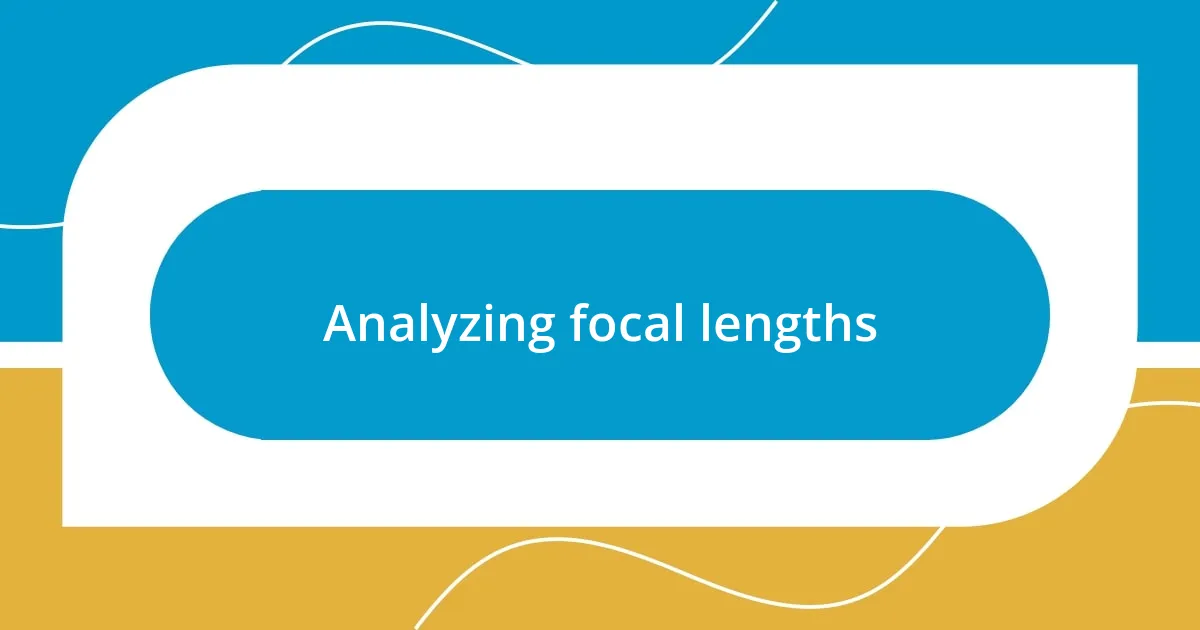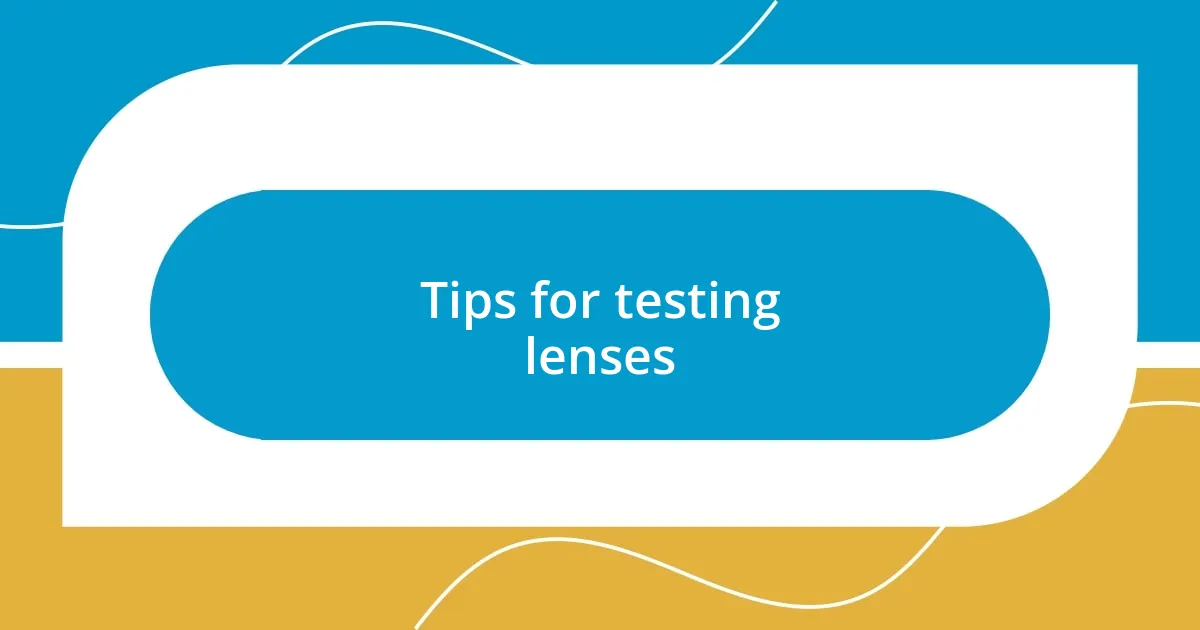Key takeaways:
- Different lens types (prime, zoom, specialty) serve unique purposes that can enhance creativity and adaptability in photography.
- Factors influencing lens choice include lighting conditions, subject matter, and personal comfort, all affecting exposure and composition.
- Understanding focal lengths and aperture settings greatly impacts the perspective, depth of field, and overall storytelling in photography.
- Weight, size, and compatibility with camera systems are crucial considerations for optimal lens selection and future-proofing in photography.

Understanding lens types
When it comes to lens types, I’ve learned that each one serves a unique purpose, shaping the way we capture images. For instance, prime lenses, with their fixed focal lengths, often produce crisper images and encourage creativity as you’re pushed to move around to frame your shot. I still remember the first time I used a 50mm prime lens—I was amazed at how it transformed everyday scenes into something magical with its beautiful depth of field.
Zoom lenses, on the other hand, offer versatility and convenience, allowing for quick adjustments without needing to change lenses. I often find myself reaching for my zoom lens during family gatherings—it lets me snap candid moments from various distances without missing a beat. Have you ever been in a situation where changing your lens would have caused you to miss the perfect shot? That’s the beauty of having a reliable zoom lens handy; it adapts to your ever-changing surroundings.
But then there are specialty lenses, like macro lenses that bring tiny worlds into focus. I once used a macro lens to photograph dew drops on a flower petal, and it felt like I was unveiling a secret universe. Isn’t it fascinating how a simple object can become extraordinary when viewed through the right lens? Understanding these different types can really open up new avenues for creative expression and help you fully realize your vision as a photographer.

Factors influencing lens choice
The choice of lens goes beyond just technical specifications; it’s influenced by the specific situations I find myself in as a photographer. For example, lighting conditions play a vital role. When I shot a sunset, the vibrant colors exploded with my wide aperture lens, allowing more light in. I still vividly remember how the lens captured the warm hues perfectly, making the whole scene feel alive.
I also can’t overlook the importance of the subject matter. When photographing wildlife, I often rely on telephoto lenses to capture distant subjects without disturbing them. There was a moment during a trip to a national park when I spotted a deer grazing far away. Using my long lens, I felt like I was part of its world while maintaining a respectful distance. It was a remarkable connection that a different lens wouldn’t have allowed.
Lastly, personal comfort with a lens cannot be underestimated. The first time I held a heavy telephoto lens, I was overwhelmed by its bulk but, as I practiced, it became a trusted companion. Now, I feel a rush of excitement when I attach it to my camera, knowing it opens up countless possibilities in my photography journey. It’s remarkable how our comfort level can shape our experience and results.
| Factor | Description |
|---|---|
| Lighting Conditions | Affects the choice of lens type, especially regarding aperture size. |
| Subject Matter | Determines if a wide-angle, standard, or telephoto lens is appropriate. |
| Personal Comfort | Influences how effectively a lens is used and the photographer’s confidence. |

Analyzing focal lengths
When analyzing focal lengths, I’ve come to appreciate how significantly they influence the perspective and storytelling of an image. For instance, using a wide-angle lens for landscape photography allowed me to capture the grandeur of a mountain range in its entirety. I still recall standing at the foot of the mountains, feeling small but inspired, as the expansive view unfolded through my lens—it was almost like I was giving viewers a window into that awe-inspiring moment.
With focal lengths, it’s essential to consider how they impact composition and subject isolation. A longer focal length makes distant subjects feel closer, which can create intimacy in portraits. I once aimed my 85mm lens at a friend during a candid moment in a café; the result was a breathtaking image that not only captured her expression but also blurred out the hustle and bustle around her, making her the undeniable focus of that fleeting moment.
- Wide-angle (14-35mm): Great for landscapes or architecture, providing a broad view.
- Standard (35-70mm): Versatile for everyday shots; it represents a natural perspective.
- Telephoto (70mm and above): Perfect for portraits and wildlife, offering compression and detail from a distance.
Understanding these nuances of focal lengths has transformed how I approach each shot and what stories I’m able to tell through my photography. It’s amazing how a simple adjustment in focal length can evoke different emotions and reactions in viewers.

Evaluating aperture settings
Evaluating aperture settings is crucial for achieving the desired impact in your photography. I remember the first time I shot in a low-light situation, my initial struggle with getting the right exposure taught me the value of a wide aperture. It was exhilarating to see how a larger f-stop number, like f/2.8, allowed me to capture the soft glow of city lights, adding an enchanting quality to my nighttime shots.
But aperture is not just about light; it plays a substantial role in depth of field. I’ve experimented with various aperture settings on portraits, and I can’t emphasize enough how a wide aperture can create that beautiful bokeh effect, making the subject stand out against a softly blurred background. Remember that evening portrait session? By using an aperture of f/1.8, I could isolate my friend from the chaotic background, turning a regular shot into something magical. Isn’t it amazing how a simple adjustment in aperture can transform the focus of an image?
Moreover, understanding aperture settings also leads to a greater understanding of the balance in photography. While a wide aperture is fantastic for low light and isolation, sometimes I’ve found that a narrower setting is necessary to capture more detail across a wider scene, such as when I was photographing a sprawling landscape at f/11. It felt rewarding to have every element in focus, reflecting the serenity of that moment. What decisions have you made with your aperture that changed the outcome of your photo?

Importance of image stabilization
Image stabilization (IS) is a game-changer in photography, especially for anyone who’s tried to capture a fleeting moment while battling shaky hands or an unsteady platform. I still remember an afternoon at the beach—waves crashing, seagulls soaring, and my excitement led to a bit of a shaky grip. Thanks to my lens’s IS feature, I managed to get sharp, clear images despite the breeze that made my hands quiver. It’s like having a safety net; it gives you the confidence to shoot in less-than-ideal conditions.
Now, consider the benefits of IS when using longer focal lengths. When I recently ventured into wildlife photography, I encountered the challenge of keeping up with a darting bird. My telephoto lens, equipped with stabilization, transformed what could have been a frustrating experience into a triumphant moment. Without that technology, even the slightest movement could have blurred my shots, but instead, I captured a crisp image of the bird mid-flight, its wings caught in the light. Imagine the disappointment of missing such a rare shot—IS truly makes a difference in those telltale moments.
Moreover, shooting in low light conditions—like during a vibrant sunset—can often lead to less-than-ideal results without IS. I vividly recall a sunset where the colors danced across the sky; my excitement prompted me to snap photos as quickly as possible, often without entirely bracing myself. Thanks to image stabilization, I obtained beautifully detailed images with rich colors rather than blurred, washed-out silhouettes. Doesn’t it feel great when a tool like this lets you seize the moment exactly as you see it? It’s not just about capturing a picture, but rather, it’s about preserving a beautiful memory in sharp focus.

Tips for testing lenses
When testing lenses, it’s essential to evaluate their sharpness at various apertures. I remember my excitement the first time I discovered that a lens can behave differently depending on the f-stop. By analyzing sharpness in real time, I realized that my favorite lens performed best at f/5.6, which dramatically improved the clarity of my landscapes. Isn’t it fascinating how tweaking that small dial can unlock such potential?
Another tip is to assess the lens’s performance in real-world scenarios. For example, I often take my camera out for a test drive in diverse settings, from bustling streets to serene nature trails. Each location tells a different story, and I love observing how the lens interacts with the light and environment. This hands-on approach has taught me to appreciate the subtle nuances of each lens—like that one creamy bokeh that made a portrait pop during golden hour. What have you discovered about your lenses by taking them out for a spin?
Lastly, don’t forget to test focus accuracy, especially with autofocus lenses. I had a moment where I missed a pivotal shot because the autofocus didn’t lock onto my subject as I expected. It was a harsh lesson, but now I make sure to take a few test shots in challenging situations. By being proactive, I can adjust my settings or even choose a different lens if necessary. How do you ensure your gear is ready when that perfect moment finally arrives?

Final considerations for optimal selection
When considering lens selection, don’t overlook the importance of weight and size. I remember lugging around a hefty lens during a long hike, and by the time I reached my destination, I was physically drained. It made me wonder: is the extra weight worth it for the extra capabilities? For travel or on-the-go photography, a lighter lens can be a lifesaver, allowing you to take more shots without feeling like you’re carrying a brick.
Another critical aspect is the future proofing of your lens. Early in my photography journey, I invested in a mid-range lens, only to realize soon after that I wanted to push my skills further. That lens, despite being decent, limited my creative options. When you invest in a lens, think about your growth as a photographer. Will this lens adapt with you, or will it become an anchor as you strive for more advanced techniques?
Compatibility with your camera system shouldn’t be an afterthought either. I once purchased a fantastically reviewed lens that, when it arrived, didn’t play nicely with my camera in a crucial moment at an event. That encounter taught me the value of researching compatibility. If you’re excited about a lens because of its capabilities, double-check its fit. After all, a great lens should enhance your experience, not hinder it.














